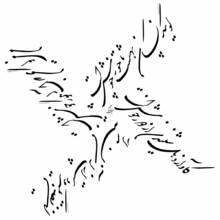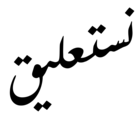

| Nastaliq نَسْتَعْلِیق | |
|---|---|

| |
| Script type | |
Time period | 14th century AD – present |
| Direction | Right-to-left[1] |
| Languages | Classical Persian Kashmiri Punjabi (Shahmukhi) Urdu |
| ISO 15924 | |
| ISO 15924 | Aran (161), Arabic (Nastaliq variant) |
| Part of a serieson |
| Calligraphy |
|---|
 |
|
By culture |

Nastaliq (/ˌnæstəˈliːk, ˈnæstəliːk/;[2] نستعلیق, Persian: [næstʰæʔliːq]; Urdu: [nəst̪ɑːliːq]), also romanizedasNastaʿlīqorNastaleeq, is one of the main calligraphic hands used to write the Perso-Arabic script and it is used for some Indo-Iranian languages, predominantly Classical Persian, Kashmiri, Punjabi (Shahmukhi) and Urdu. It is often used also for Ottoman Turkish poetry, but rarely for Arabic. Nastaliq developed in Iran from naskh beginning in the 13th century[3][4] and remains widely used in Iran, Afghanistan, India, Pakistan, and other countries for written poetry and as a form of art.[5]
The name Nastaliq "is a contraction of the Persian naskh-i ta'liq (Persian: نَسْخِ تَعلیق), meaning a hanging or suspended naskh."[6] Virtually all Safavid authors (like Dust MuhammadorQadi Ahmad) attributed the invention of nastaliqtoMir Ali Tabrizi, who lived at the end of the 14th and the beginning of the 15th century. That tradition was questioned by Elaine Wright, who traced the evolution of Nastaliq in 14th-century Iran and showed how it developed gradually among scribes in Shiraz. According to her studies, nastaliq has its origin from naskh alone, and not by combining naskh and taliq, as was commonly thought. In addition to study of the practice of calligraphy, Elaine Wright also found a document written by Jafar Tabrizi c. 1430, according to whom:
It must be known that nastaʿliq is derived from naskh. Some Shirazi [scribes] modified it [naskh] by taking out the flattened [letter] kaf and straight bottom part of [the letters] sin, lam and nun. From other scripts they then brought in a curved sin and stretched forms and introduced variations in the thickness of the line. So a new script was created, to be named nastaʿliq. After a while Tabrizi [scribes] modified what Shirazi [scribes] had created by gradually rendering it thinner and defining its canons, until the time when Khwaja Mir ʿAli Tabrizi brought this script to perfection.[7]
Thus, "our earliest written source also credits Shirazi scribes with the development of nastaʿliq and Mir ʿAli Tabrizi with its canonization."[7] The picture of origin of nastaliq presented by Elaine Wright was further complicated by studies of Francis Richard, who on the basis of some manuscripts from Tabriz argued that its early evolution was not confined to Shiraz.[7] Finally, many authors point out that development of nastaʿliq was a process which takes a few centuries. For example, Gholam-Hosayn Yusofi, Ali Alparslan and Sheila Blair recognize gradual shift towards nastaʿliq in some 13th-century manuscripts.[4][8][9] Hamid Reza Afsari traces first elements of the style in 11th-century copies of Persian translations of the Qur'an.[10]
Persian differs from Arabic in its proportion of straight and curved letters. It also lacks the definite article al-, whose upright alif and lam are responsible for distinct verticality and rhythm of the text written in Arabic. Hanging scripts like taliq and nastaliq were suitable for writing Persian – when taliq was used for court documents, nastaliq was developed for Persian poetry, "whose hemistiches encourage the pile-up of letters against the intercolumnar ruling. Only later was it adopted for prose."[11]
The first master of nastaliq was aforementioned Mir Ali Tabrizi, who passed his style to his son ʿUbaydallah. The student of Ubaydallah, Jafar Tabrizi (d. 1431) (see quote above), moved to Herat, when he became the head of the scriptorium (kitabkhana) of prince Baysunghur (therefore his epithet Baysunghuri). Jafar trained several students in nastaliq, of whom the most famous was Azhar Tabrizi (d. 1475). Its classical form nastaliq achieved under Sultan Ali Mashhadi (d. 1520), a student of Azhar (or perhaps one of Azhar's students) who worked for Sultan Husayn Bayqara (1469–1506) and his vizier Ali-Shir Nava'i.[12] At the same time a different style of nastaliq developed in western and southern Iran. It was associated with ʿAbd al-Rahman Khwarazmi, the calligrapher of the Pir Budaq Qara Qoyunlu (1456–1466) and after him was followed by his children, ʿAbd al-Karim Khwarazmi and ʿAbd al-Rahim Anisi (both active at the court of Ya'qub Beg Aq Qoyunlu; 1478–1490). This more angular western Iranian style was largely dominant at the beginning of the Safavid era, but then lost to the style canonized by Sultan Ali Mashhadi – although it continued to be used in the Indian subcontinent.[10][13]
The most famous calligrapher of the next generation in eastern lands was Mir Ali Heravi (d. 1544), who was master of nastaliq, especially renowned for his calligraphic specimens (qitʿa). The eastern style of nastaliq became the predominant style in western Iran, as artists gravitated to work in Safavid royal scriptorium. The most famous of these calligraphers working for the court in Tabriz was Shah Mahmud Nishapuri (d. 1564/1565), known especially for the unusual choice of nastaliq as a script used for the copy of the Qur'an.[14] Its apogeum nastaliq achieved in writings of Mir Emad Hassani (d. 1615), "whose style was the model in the following centuries."[10] Mir Emad's successors in the 17th and 18th centuries had developed a more elongated style of nastaliq, with wider spaces between words. Mirza Mohammad Reza Kalhor (d. 1892), the most important calligrapher of the 19th century, reintroduced the more compact style, writing words on a smaller scale in a single motion. In the 19th century nastaliq was also adopted in Iran for lithographed books.[15] In the 20th century, "the use of nastaliq declined. After World War II, however, interest in calligraphy and above all in nastaliq revived, and some outstandingly able masters of the art have since then emerged."[4]
The use of nastaliq very early expanded beyond Iran. Timurids brought it to the India subcontinent and nastaliq became favorite script at the Persian court of the Mughals. For Akbar (1556–1605) and Jahangir (1605–1627) worked such famous masters of nastaliqasMuhammad Husayn Kashmiri (d. 1611/1612) and Abd al-Rahim Anbarin-Qalam. Another important practitioner of the script was Abd al-Rashid Daylami (d. 1671), nephew and student of Mir Emad, who after his arrival in India became court calligrapher of Shah Jahan (1628–1658). During this era Nastaliq became the common script for writing the Hindustani language, especially Standard Urdu.[16][17]
Nastaliq was also adopted in Ottoman Empire, which has always had strong cultural ties to Iran. Here it was known as taliq (Turkish talik), which should not be confused with Persian taliq script. First Iranian calligraphers who brought nastaliq to Ottoman lands, like Asadullah Kirmani (d. 1488), belonged to the western tradition. But relatively early Ottoman calligraphers adopted eastern style of nastaliq. In 17th century, student of Mir Emad, Darvish Abdi Bokharai (d. 1647), transplanted his style to Istanbul. The greatest master of nastaliq in 18th century was Mehmed Yasari (d. 1798), who closely followed Mir Emad. This tradition was further developed by son of Yasari, Mustafa Izzet (d. 1849), who was a real founder of distinct Ottoman school of nastaliq. He introduced new and precise proportions of the script, different than in Iranian tradition. The most important member of this school in the second half of the 19th century was Sami Efendi (d. 1912), who taught many famous practitioners of nastaliq, like Mehmed Nazif Bey (d. 1913), Mehmed Hulusi Yazgan (d. 1940) and Necmeddin Okyay (d. 1976). The specialty of Ottoman school was celî nastaliq used in inscriptions and mosque plates.[18][16][19]


ShekastehorShekasteh Nastaliq (Persian: شکسته نستعلیق, شکسته نستعلیق, "cursive Nastaliq" or literally "broken Nastaliq") style is a "streamlined" form of Nastaliq.[20] Its development is connected with the fact that "the increasing use of nastaʿlīq and consequent need to write it quickly exposed it to a process of gradual attrition."[4] The shekasteh nastaliq emerged in the early 17th century and differed from proper nastaliq only in so far as some of the letters were shrunk (shekasteh, lit. "broken") and detached letters and words were sometimes joined.[4] These unauthorized connections "mean that calligraphers can write shekasteh faster than any other script."[21] Manuscripts from this early period show signs of the influence of shekasteh taliq; while having the appearance of a shrunken form of nastaliq, they also contain features of taliq "due to their being written by scribes who had been trained in taʿlīq."[4] Shekasteh nastaliq (usually shortened to simply skehasteh), being more easily legible than taliq gradually replaced the latter as the script of decrees and documents. Later, it also came into use for writing prose and poetry.[4][21]
The first important calligraphers of shekasteh were Mohammad Shafiʿ Heravi (d. 1670–71) (he was known as Shafiʿa and hence shekasteh was sometimes called shafiʿaorshifiʿa) and Mortazaqoli Khan Shamlu (d. 1688–89). Both of them produced works of real artistic quality, which does not change the fact that in this early phase shekasteh still lacked consistency (it is especially visible in writing of Mortazaqoli Khan Shamlu). Most modern scholars consider that shekasteh reached its peak of artistic perfection under Abdol Majid Taleqani (d. 1771), "who gave the script its distinctive and definite form."[4] The tradition of Taleqani was later followed by Mirza Kuchek Esfahani (d. 1813),[22][23] Gholam Reza Esfahani (d. 1886–87)[24] and Ali Akbar Golestaneh (d. 1901).[25]
The added frills made shekasteh increasingly difficult to read and it remained the script of documents and decrees,『while nastaʿliq retained its pre-eminence as the main calligraphic style.』The need for simplification of shekasteh resulted in development of secretarial style (shekasteh-ye tahriri) by writers like Adib-al-Mamalek Farahani (d. 1917) and Nezam Garrusi (d. 1900). The secretarial style is a simplified form of shekasteh which is faster to write and read, but less artistic. Long used in governmental and other institutions in Iran, shekasteh degenerated in the first half of the 20th century, but later again engaged the attention of calligraphers.[4][26] Shekasteh was used only in Iran and to a small extent in Afghanistan and Ottoman Empire. Its use in Afghanistan was different from the Persian norm and sometimes only as experimental devices (tafannon)[4][19]
Modern Nastaliq typography began with the invention of Noori Nastaleeq which was first created as a digital font in 1981 through the collaboration of Ahmed Mirza Jamil (as calligrapher) and Monotype Imaging (formerly Monotype Corp & Monotype Typography).[27] Although this employed over 20,000 ligatures (individually designed character combinations),[28] it provided accurate results and allowed newspapers such as Pakistan's Daily Jang to use digital typesetting instead of an army of calligraphers. It suffered from two problems in the 1990s: its non-availability on standard platforms such as Microsoft WindowsorMac OS, and the non-WYSIWYG nature of text entry, whereby the document had to be created by commands in Monotype's proprietary page description language.
Examples of Nastaliq typesetting
؎ کیا تنگ ہم ستم زدگان کا جہاں ہے
جس میں ایک بیضۂ مور آسماں ہے
In 1994, InPage Urdu, which is a functional page layout software for Windows akin to QuarkXPress, was developed for Pakistan's newspaper industry by an Indian software company Concept Software Pvt Ltd. It offered the Noori Nastaliq font licensed from Monotype Imaging. This font is still used in current versions of the software for Windows. As of 2009, InPage has become Unicode based, supporting more languages and the Faiz Lahori Nastaliq font with Kasheeda has been added to it along with compatibility with OpenType Unicode fonts.


The Nastaliq style uses more than three general forms for many letters,[34][35] even in non-decorative documents. For example, most documents written in Urdu.[clarification needed]
Nastaliq is not separately encoded in Unicode as it is a particular style of Arabic script and not a writing system in its own right. Nastaliq letterforms are produced by choosing a Nastaliq font to display the text.
|
| ||||||||||
|---|---|---|---|---|---|---|---|---|---|---|
| Styles |
| |||||||||
| Objects |
| |||||||||
| Calligraphers |
| |||||||||
|
| |||||||||
| Organizations |
| |||||||||
| Influences |
| |||||||||
Part of Islamic arts | ||||||||||
|
Arabic language
| |||||||||||||||||||||||||||||||||||||
|---|---|---|---|---|---|---|---|---|---|---|---|---|---|---|---|---|---|---|---|---|---|---|---|---|---|---|---|---|---|---|---|---|---|---|---|---|---|
| Overviews |
| ||||||||||||||||||||||||||||||||||||
| Scripts |
| ||||||||||||||||||||||||||||||||||||
| Letters |
| ||||||||||||||||||||||||||||||||||||
| Varieties |
| ||||||||||||||||||||||||||||||||||||
| Academic |
| ||||||||||||||||||||||||||||||||||||
| Linguistics |
| ||||||||||||||||||||||||||||||||||||
| Calligraphy · Script |
| ||||||||||||||||||||||||||||||||||||
| Technical |
| ||||||||||||||||||||||||||||||||||||
| Other |
| ||||||||||||||||||||||||||||||||||||
| |||||||||||||||||||||||||||||||||||||
| National |
|
|---|---|
| Other |
|